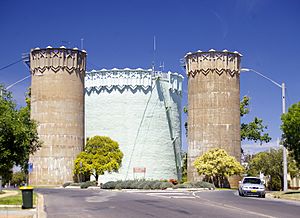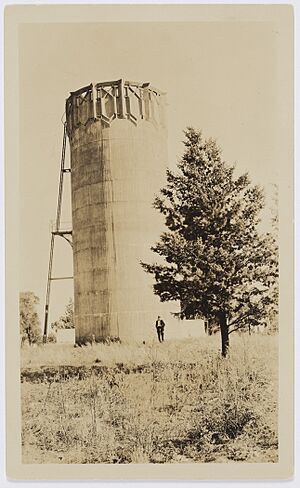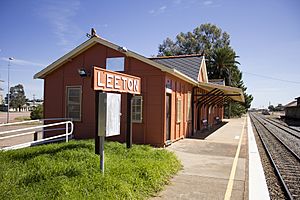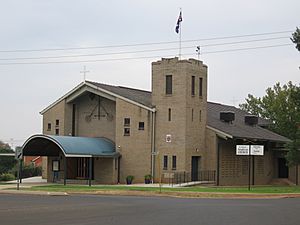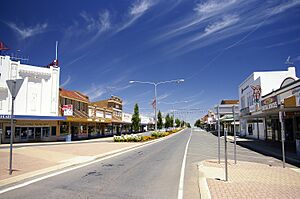Leeton, New South Wales facts for kids
Quick facts for kids LeetonNew South Wales |
|||||||||
|---|---|---|---|---|---|---|---|---|---|
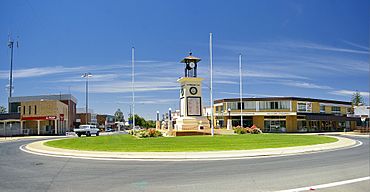
Leeton War Memorial
|
|||||||||
| Population | 7,437 (2021 census) | ||||||||
| Established | 2 April 1913 | ||||||||
| Postcode(s) | 2705 | ||||||||
| Elevation | 138.3 m (454 ft) | ||||||||
| Location |
|
||||||||
| LGA(s) | Leeton Shire | ||||||||
| County | Cooper | ||||||||
| Parish | Willimbong | ||||||||
| State electorate(s) | Murray | ||||||||
| Federal Division(s) | Farrer | ||||||||
|
|||||||||
Leeton is a town in the Riverina region of New South Wales, Australia. It is located in the Murrumbidgee Irrigation Area, a special farming region. Leeton is the main town for the Leeton Shire Council, which also includes nearby places like Yanco and Whitton.
The famous architect Walter Burley Griffin designed the town. It was built in the early 1900s for a big farming project by the New South Wales government. Leeton is known for growing many crops like citrus fruits, rice, cotton, and grapes. It's often called Australia's Rice Capital because SunRice, a huge food company, has its main office there. Other important businesses include Arnott's Biscuits and Webster Limited.
Tony Reneker is the current mayor of Leeton.
Contents
History of Leeton
Before European settlers arrived, the Wiradjuri people lived in this area. The town got its name from Charles Alfred Lee. He was a Minister for Public Works in New South Wales from 1904 to 1910.
In 1912, a water tower was built to bring water to the new town. The Leeton Post Office opened on 6 September 1912. When the Water Conservation and Irrigation Commission of New South Wales started in 1913, Leeton was mostly a "canvas town." This meant many people lived in tents, and only a few houses were built for farmers or government workers.
On 22 January 1913, Leeton was officially declared a town. The first piece of land was sold on April 3, 1913. That same year, a Kurrajong tree was planted in the middle of Kurrajong Avenue. This tree later became known as the Pioneers' Tree. A butter factory also opened in 1913. In August, Walter Burley Griffin visited to finish designing the town.
When World War I started in 1914, 200 men from Leeton's population of 2,000 joined the military. Between 1914 and 1915, a meat processing plant and a canning factory were built in the town.
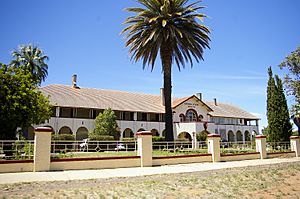
The Hydro Hotel was built in 1919 for important visitors. It wasn't allowed to sell alcohol until 1924, when the ban on alcohol in the Murrumbidgee Irrigation Area was lifted.
In 1928, the Willimbong Shire was formed to manage the local area. It was renamed Leeton Shire in 1946.
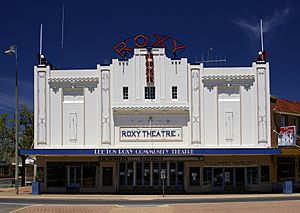
The Roxy Theatre was built in 1929 and opened in April 1930. It became an important place for entertainment.
The Leeton Racecourse, which started in 1912, became managed by the Willimbong Shire in 1930. In 1931, the famous plane Southern Cross was the first aircraft to land at the aerodrome. Commercial flights to Sydney began in 1935 but stopped in 1936 after a plane crash.
During the 1930s, the Willimbong Shire took over the town's water supply. A second water tower was finished in 1937, right next to the first one.
The town's swimming baths were built by volunteers and opened in 1932. Later, in 1962, the modern Leeton & District Memorial Swimming Pool was opened. Money for it was raised through the Irrigana Festival and a loan.
Rice farming became very important during World War II. The government encouraged it to help feed the soldiers. Farmers like Norm Houghton helped develop new types of rice for the area. The Irrigana Festival started in 1959 to celebrate the town. Later, it was renamed the "Rice Bowl Festival" and then the "Sunwhite Rice Festival."
Heritage-Listed Places
Leeton has several places that are protected because of their history. These include:
- Hydro Hotel
- Koonadan Historic Site
- Leeton District Lands Office
- Leeton District Office artefacts
- Leeton railway station
- Roxy Community Theatre
Education in Leeton
Leeton is the second largest education center in the Riverina region, after Wagga Wagga.
Leeton Shire has three high schools:
- Leeton High School
- St Francis de Sales Regional College
- Yanco Agricultural High School
Leeton Shire has six primary schools:
- Leeton Public School
- Parkview Public School
- St Joseph's Primary School
- Wamoon Public School
- Yanco Public School
- Whitton Public School
Other education options include:
- TAFE NSW Riverina Institute
- Murrumbidgee College of Agriculture
- Gralee Support School
- MET School (Leeton Campus)
- Leeton Pre-School
- Leeton Early Learning Centre
- Goodstart Early Learning
Climate in Leeton
Leeton has a cold semi-arid climate. This means it has hot, dry summers and cool, partly cloudy winters. The town enjoys about 137 clear days each year.
| Climate data for Leeton Caravan Park (1913−1975, rainfall to 2005); 140 m AMSL; 34.57° S, 146.41° E | |||||||||||||
|---|---|---|---|---|---|---|---|---|---|---|---|---|---|
| Month | Jan | Feb | Mar | Apr | May | Jun | Jul | Aug | Sep | Oct | Nov | Dec | Year |
| Record high °C (°F) | 44.3 (111.7) |
43.9 (111.0) |
38.3 (100.9) |
32.4 (90.3) |
27.2 (81.0) |
28.3 (82.9) |
25.2 (77.4) |
25.0 (77.0) |
33.5 (92.3) |
36.0 (96.8) |
41.4 (106.5) |
42.2 (108.0) |
44.3 (111.7) |
| Mean daily maximum °C (°F) | 31.9 (89.4) |
31.2 (88.2) |
28.2 (82.8) |
22.9 (73.2) |
18.1 (64.6) |
14.7 (58.5) |
13.9 (57.0) |
15.8 (60.4) |
19.3 (66.7) |
23.0 (73.4) |
27.0 (80.6) |
30.2 (86.4) |
23.0 (73.4) |
| Mean daily minimum °C (°F) | 17.2 (63.0) |
17.2 (63.0) |
14.6 (58.3) |
10.4 (50.7) |
7.0 (44.6) |
4.6 (40.3) |
3.7 (38.7) |
4.6 (40.3) |
6.6 (43.9) |
9.7 (49.5) |
12.7 (54.9) |
15.6 (60.1) |
10.3 (50.5) |
| Record low °C (°F) | 8.4 (47.1) |
7.8 (46.0) |
3.9 (39.0) |
1.7 (35.1) |
−1.2 (29.8) |
−3.9 (25.0) |
−3.9 (25.0) |
−3.2 (26.2) |
−2.7 (27.1) |
0.6 (33.1) |
4.0 (39.2) |
6.1 (43.0) |
−3.9 (25.0) |
| Average precipitation mm (inches) | 32.4 (1.28) |
30.6 (1.20) |
33.1 (1.30) |
35.0 (1.38) |
39.2 (1.54) |
39.8 (1.57) |
37.1 (1.46) |
40.9 (1.61) |
37.4 (1.47) |
44.7 (1.76) |
30.8 (1.21) |
31.2 (1.23) |
432.3 (17.02) |
| Average rainy days | 4.0 | 3.7 | 4.0 | 5.1 | 7.2 | 8.6 | 9.6 | 9.6 | 7.7 | 7.3 | 5.0 | 4.7 | 76.5 |
Getting to Leeton
Leeton is about 450 km from Melbourne and 550 km from Sydney. You can fly into Narrandera Airport, which is about 20 km away. Regional Express has daily flights there.
There are also bus services to Sydney and Adelaide from the Leeton Coach Terminal. You can also take a bus to Wagga Wagga to connect with train services to Sydney and Melbourne. A train service to Griffith stops at Leeton railway station on Wednesdays and Saturdays.
Industries in Leeton
Processing farm products is Leeton's biggest industry. Ricegrowers Limited, known as SunRice and CopRice, is the largest employer. Their international headquarters, a rice mill, and factories are in Leeton.
Other big companies include The Daily Juice Company, JBS Australia, Murrumbidgee Irrigation Limited, and Pacific Fresh. There are also local wineries like Toorak Wines and Lillypilly Wines. The Arnott's Group is nearby in Stanbridge.
The Vance Industrial Estate is home to many smaller industrial businesses.
Places to Visit in Leeton
Leeton has many interesting landmarks. These include the Roxy Theatre, the War Memorial, Madonna Place, St Peter's Church, and the Burley Griffin water towers.
Outdoors and Nature
The Ramsar-listed Fivebough and Tuckerbil Wetlands are great for walking and birdwatching. The nearby Murrumbidgee River and Murrumbidgee Valley National Park also offer chances to explore nature.
Media in Leeton
Leeton's local newspaper is The Irrigator. It comes out on Tuesdays and Fridays. You can listen to local radio stations like ABC Riverina (100.6 FM), Star FM (99.7 FM), and 2RG. WIN Television also broadcasts local news for the Riverina region on weeknights.
Sports in Leeton
Leeton has several sports teams:
- The Leeton Greens play rugby league in the Group 20 Rugby League competition. They have won eight championships.
- The Leeton-Whitton Crows play Australian rules football in the Riverina Football League. They were formed in 1995 and won their first championship in 2017.
- Leeton United Football Club plays soccer in the Griffith District Football Association. The club started in 1962.
Famous People from Leeton
Many notable people have come from Leeton, including:
- Kurt Aylett - Australian rules footballer
- Linda Burney - A politician who is currently the Minister for Indigenous Australians.
- John Faulkner - A politician who was a Senator.
- Matthew Dunn - An Olympic swimmer who won seven gold medals at the Commonwealth Games.
- Ross Elwin - Australian rules footballer
- Rod Maybon - A National Rugby League player.
- Robert McLachlan - A professional road bicycle racer.
- Peter Peters - A National Rugby League player and commentator.
- Jay Bandy - Former National Rugby League player.
- Mathew Feagai - National Rugby League player.
- Max Feagai - National Rugby League player.
- Clint Halden - Former National Rugby League player.
- Jeff Robson - Former National Rugby League player.
- Mark Taylor - Former captain of the Australia national cricket team and a cricket commentator.
- Helen Wellings - A consumer advocate.
- Craig Nettelbeck - Former Australian Football League footballer.
- Max Kruse - Former VFL footballer.
- Jacob Hopper - AFL footballer.
- Cooper Sharman - Australian rules footballer.
- Jacob Townsend - Former AFL and current VFL footballer.
The famous Australian poet and writer Henry Lawson lived in Leeton for two years (1916-1917). He was hired to write about the Murrumbidgee Irrigation Area to encourage people to move there.
Images for kids



